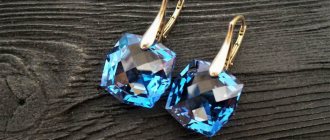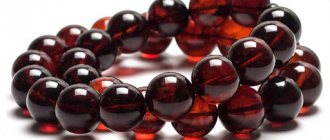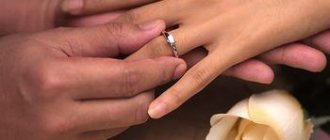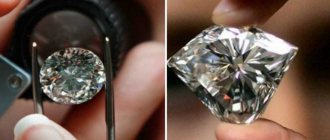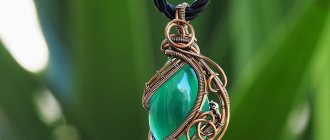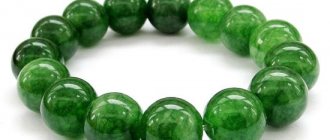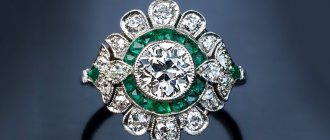Coral is a very interesting stone, primarily due to its unusual organic origin.
It is created by coral polyps living in warm tropical seas. Humanity has known about this unique mineral for quite a long time - at least since the beginning of our era. However, the history of coral may be coming to an end, and our children will no longer be able to buy a unique talisman. Due to increasing pollution of the world's oceans, the number of coral polyps is steadily declining. Nevertheless, for now you can still find relatively inexpensive jewelry - of course, if it suits your energy.
History and origin
Coral is neither a mineral nor a plant, and the history of the first finds stretches back to the distant past - about 25 thousand years ago. Even then, people living near the warm waters of the Mediterranean discovered the amazing creation of nature.
However, at first only sailors and divers could admire the true beauty of Poseidon’s domains. The coral “branches” raised to the surface quickly lost their appearance under the influence of the sun and air. Soon the craftsmen mastered the technique of polishing the stone creations of the sea, returning them to their natural beauty for life on land. At the same time, conscious coral mining began.
This is interesting!
Proof that the exotic seas were accessible to the ancients are findings from the Paleolithic era - pink coral beads were discovered in the Viddsheyer cave, which served as a site for nomadic peoples.
Even in ancient times, coral was considered a stone of peace, helping a person find harmony with himself. Therefore, among the ancient Egyptians, jewelry made from nuggets were talismans of patience, restraint, and a cure against melancholy and sadness. Also, the gift of the seas was a symbol of immortality.
The Greeks, like the Egyptians, identified corals with eternal life. Amulets were made from fossils to help ward off diseases and misfortunes, attracting happiness and good luck to the owner. The Sumerians considered the nugget to be divine. And the ancient Roman physician Paracelsus claimed that a gem from the depths of the sea drives away evil spirits. Later, the whole of Europe was convinced of this.
The Middle Ages were marked by a new round of popularity for corals. And not bohemian, but brass. People believed in the ability of the stone to protect from evil spirits, demons, and temptations. Representatives of the European clergy acquired coral rosaries. Babies' cradles were complemented with nugget amulets, and older children were supposed to wear various jewelry as protective talismans.
This is interesting!
For Europeans, corals were a symbol of modesty and virtue. The first decoration of a young girl should be beads made of sea gems or gold earrings with coral inserts. It was believed that the stone ensures success in relationships with men. In addition, people began to notice a certain effect on their appearance - their complexion evened out, their skin became more youthful and attractive.
Coral, both previously and now, is considered a talisman for travelers. On a long journey, gem beads will help you avoid troubles and will also prevent you from getting lost in an unfamiliar place. The energy of the stone provokes a person to go in search of adventures and exploits.
The name of the exotic nugget came into the Russian language from ancient Greek, having first passed through Latin, Polish and German.
The natural origin of corals is the organic remains of marine invertebrate animals. These organisms, called coral polyps, are endowed with a skeleton made of lime, which is involved in the formation of reefs. The process of creating a reef takes centuries. The island of coral has been growing for hundreds of centuries. This is due to the slow growth of the fossil - about 1 centimeter per year
Description and distribution
Photo of red corals
Corals have annual rings similar to those of trees. Some coral branches are hundreds of years old.
Typical brain corals grow primarily in the tropics, where the water remains warm all year. Because of their hard structure, brain corals can live in ocean currents and strong waves. Thinner plate corals can only survive in sheltered lagoons or deeper water. Large, hard coral heads often serve as a "cleaning station" for some species of animals and fish. They rub against the coral, removing dead skin or parasites.
Ultraviolet light can harm corals in shallow waters. If a decrease in the Earth's protective ozone layer allows more ultraviolet radiation to reach land, corals could disappear from habitats such as shallow waters.
Coral reefs were found in the cold waters of the Atlantic Ocean near Scotland.
There are several types of corals: tree-shaped, fan-shaped, etc.
The largest coral reef is located off the northeast coast of Australia. It extends over a distance of 2200 km.
Antiquity
According to Greek mythology, red corals appeared from the blood of the Gorgon beheaded by Perseus[4]. The name of one of the types of corals - gorgonians - goes back to this story.
In ancient times, coral was considered a kind of fossilized algae. Pedanius Dioscurides, describing the healing properties of corals, calls them “sea trees.” Ancient authors recognized the ability of corals to transform (sea) bitter water into drinkable water and provide immunity against poison.
Places and methods of extraction
Coral
These marine inhabitants live in tropical regions where the sea is warm all year round. They can be located either close to the surface of the water or at a depth of up to 300 m. The coasts with the largest number of coral reefs include: Japan, Sardinia, Taiwan, Turkey, Yugoslavia and Australia. They can be found off the coast of the Canary and Midway Islands and on the African coast.
The mineral is extracted in two ways:
- On an industrial scale, a mesh with large cells is used. It is dragged along the bottom, collecting a lot of working material at a time. The disadvantage of this method is that in the process most of them break, becoming unsuitable for jewelry making.
- With less damage, you can collect corals by hand. This is done by people who have completed training courses. However, this method also has its disadvantages. Firstly, it takes longer. Secondly, the work of a coral collector is dangerous and can even lead to death.
How corals are mined
Place of Birth
The mineral is mined in tropical waters. Since coral is, in fact, the remains of living beings, it grows on its own in the favorite places where polyps live. These include the seabed at a depth of 3-5 meters. Some kind of “bushes” form there. Previously, they dived for them, now they catch them with a special net.
Black corals are one of the most valuable.
After extraction, such a “bush” is processed: all soft parts that have not had time to become saturated with sea salt and crystallize are removed. The stones are then sorted by appearance and defects. Only after this can they be carried for sale.
Coral is harvested on an industrial scale where climate conditions allow it to grow as densely as possible. This requires extensive shallows and an average annual temperature of around twenty degrees. The following countries actively supply stones to the market:
- Italy;
- Algeria;
- Tunisia;
- Australia;
- Egypt;
- Canary Islands;
- Samoa;
- Japan.
Stones of a black or deep dark blue hue are very highly valued. They are mined in the Red Sea, on the islands of the Malay Archipelago, as well as along the coast of India. Unfortunately, the number of polyps in these places is now declining.
Physicochemical characteristics
Coral is an opaque stone that is translucent around the edges. The hardness of the mineral is low: for red varieties it is 3-4 according to Mohs, for black varieties it is two times lower. As a result, the coral is easily scratched by a knife.
In its raw form, the stone has a matte, even rough surface. It is rubbed with special wax polishes, giving it a silky shine.
When worn, natural corals may fade and turn pale. But the most common reason for this phenomenon is poor-quality painting. Cheap white and even pink corals are dipped in hydrogen peroxide to impart the popular red hue, and are also treated with chemical dyes.
Types and colors of corals
The palette of corals is very rich. Biologists have identified more than two thousand varieties of polyps. Each of them creates its own unique type of stone. The color can be anything you can imagine. Since it is impossible to remember all these subtypes, there is a special jewelry classification that groups similar varieties into categories.
- The silvery-pink coral is called "pelle d'angelo" (angel skin in Italian).
Pelle D'angelo
- Bright stones the color of dawn are classified as “Rose Vivo”.
Rose Vivo
- White coral is classified as bianco. This is a very rare variety that is used only in jewelry.
Coral Bianco
- Pink-orange stones are called “second color”.
Secondo Coloro
- Black coral is classified as the “Akkabar” subtype. It contains no calcium, only keratinized organic matter - dead polyps.
Coral Akkabar
- Blue coral is also a rare variety. Bright specimens are especially valued - some “craftsmen” can even use it to imitate sapphires.
Blue coral
- The most classic variety is the bright red coral, “rosso”. This is what is mined off the coast of Italy and Algeria. Already in the Middle Ages it spread widely throughout Europe.
Coral Rosso
- Brown minerals are classified as “arquisuro carbonetto” type. These are usually small spongy specimens.
Arquisuro carbonetto
- The dark red coral is called "rosso scuro". It is mined in Japan and on the islands of Indonesia.
Rosso Scuro
The color of coral depends on the ratio of organics and inorganics in the mineral. Completely organic specimens are black. They are very rare and are listed in the Red Book; they are not mined on an industrial scale. Jewelers are forced to be content with what the sea washes ashore.
Blue coral called “akori” is also very rare. It grows off the coast of Japan. Many stone carvers dream of making something from such a unique mineral at least once in their lives.
Blue coral
Varieties of marine polyp
Almost all corals are different. Their characteristics depend on the place in which they live. Marine polyps can not only be of different shapes and colors, but also differ in composition. There are more than 2,000 species of this organic material in the world. The color range is represented by 300 different shades. There are corals of white, blue and other delicate colors, and there are also very gloomy brown or black stones. Blue and black fossils are considered the rarest.
Not all varieties of coral are used for jewelry. Jewelers use only 16 types of fossils in their business. The most expensive is red coral, which is called noble.
Silver earrings SL with cubic zirconia and coral (go to the SUNLIGHT catalog)
Inexpensive varieties of the material include ornamental fossils in white, dark red and flesh-pink colors.
The place of extraction plays an important role. The highest quality and most expensive are Japanese and African sea stones. Sea stones of African origin have branched but straight trunks. Japanese jewelry has a unique pink color.
Coral reefs from Sicily are characterized by a strongly curved trunk and are a jewel of average price and quality. Algerian, Spanish and Hawaiian are low quality sponge corals. The reason for this is the many marine microorganisms living in its branches.
Healing properties of the stone
Pink Coral
This natural stone has healing properties. It is used by healers from different countries. In ancient Rome, corals were used to heal wounds and speed up bone healing. They made powder from the stones and treated sore spots with it. In this country, the product was also used to neutralize poisons from snake bites and poisonous insects. The healing and disinfecting properties of the stone are also recognized by modern lithotherapists.
Natural stone has a positive effect on the central nervous system. It helps get out of depression, normalizes sleep and treats nervous tics.
The healing properties of coral beads have also been confirmed by lithotherapists. They are recommended to be worn for colds and throat diseases. Such beads should also be worn regularly by people whose voice is the main professional instrument, for example, singers, teachers or speakers.
This natural stone improves circulation and blood. It should be worn by people suffering from diabetes, anemia and other diseases of the circulatory system.
Red coral beads Indonesia 43 cm
Coral stone improves memory, helps to concentrate and tones.
If a person is struggling with excess weight, he needs to pay close attention to coral. It reduces appetite, therefore reducing the amount of food consumed. Weight loss also occurs due to the fact that the stone removes toxins and waste from the body.
In Japan, coral is used for dental prosthetics.
This stone can be used for early detection of diseases. To do this, you need to wear it constantly and pay attention to how it looks. If dark spots appear on its surface, the shine has disappeared, and even cracks have appeared, then this should be taken as a sign of an incipient disease. A visit to the doctor will help clarify the situation.
This is interesting!
Sea coral saved a Barnaul resident from disability. Doctors in the region performed a unique operation - instead of dead bone, an implant made of sea coral from South Korea was placed in the patient’s leg. As the traumatologist-orthopedist Ph.D. said. Alexander Chantsev, who performed the operation, replaced the damaged tissue with a coral implant, which in appearance and structure is very similar to human bone and which is not rejected by the body. The operation lasted 3 hours. You won't be able to step on your feet for another three months. And when everything grows together, the patient will be able not only to walk, but also to run.
Magical properties of corals
Pink coral beads
The magic of coral, raised from the depths of Poseidon’s domain, a priori cannot be weak. This nugget is strong in many directions, as the ancient peoples of different parts of the world were convinced of.
In ancient Greece, coral products were worn by all residents without exception. The stone symbolized for them longevity, happiness, protection from evil magic and evil spirits. The Indians of Mexico protected themselves from diseases, crop failures and the elements with the help of coral beads. They believed that all misfortunes were caused by evil spirits, and amulets helped drive them away.
And among the ancient Egyptians, coral jewelry was an attribute of young or unmarried girls, symbolizing innocence. In the modern world, the strong protective properties of coral are also recognized, helping to protect themselves from the evil eye, damage, love spells or curses, protecting young girls from bad influences.
Important!
Coral amulets are one of the few products that are suitable for protecting babies. Children are more sensitive and more often than adults are influenced by envious glances and damage. Therefore, to protect the baby and calm the hearts of parents, corals come in handy.
Esotericists use the gift of the seas to enhance psychic abilities. The nugget sharpens intuition. For Hindus, this stone is a source of wisdom and a talisman against dangers.
For travelers, coral becomes an indispensable attribute. It will protect not only from the risk of getting lost or getting caught in bad weather, but will also scare away thieves, rapists or other cruel fellow travelers.
This is interesting!
With the help of a special ritual involving raw corals, you can attract good luck to your home. Simply walk the nugget around the house in a clockwise direction, touching all windows and doors with the nugget.
Coral patronizes both men and women. White or light stones are more suitable for the fair sex, especially if the owner is very strict, stubborn, and unshakable. They will give the owner the necessary femininity, sensuality, and tenderness. Red nuggets are a talisman for men. Such corals impart resilience and masculinity. However, if a girl suffers from excessive capriciousness, sentimentality, or is melancholic, then red stones are more suitable for her, making her character more perfect.
Important!
The peak energy activity of the gem occurs during the waxing moon. But during the Full Moon, the stone becomes magically dangerous, so during these days, refrain from contact with coral jewelry.
The gifts of Poseidon will awaken in the owner those traits that are necessary to improve character and improve the quality of one’s own life. People who suffer from frivolity will become wiser. Anyone who is spoiled by life will feel more modest. Corals drive away senseless fears, worries, panic, thoughts of suicide or murder from a person, turning the owner’s inner world upside down. The stone is suitable for sensual, romantic natures, enhancing the subtlety of perception.
Coral stone in history
Coral is a name that comes from the ancient Greek word "coralion". According to one version, it means “the depths of the sea,” according to another, “hardening in the hand.” In the ancient world, the fashion for wearing talismans from the depths of the ocean was spread by Celtic tribes, but what they called them is unknown.
Living polyp corals.
In Rus', sea corals were sometimes called “kings” - this is a folk etymology that emphasizes the “royal” beauty of the stones. They were used everywhere as protective talismans and magical amulets. They also paid tribute to the decorative properties of organic material. Figurines were cut out of it and finishing tiles were made. Clothes were also decorated with coral beads.
In Poland and Ukraine, as well as in some other countries, coral beads are considered an integral part of ethnographic women's costume. In the old days, it was believed that the more such jewelry a girl put on, the richer and more wealthy her family was. The stone was usually brought from the south, from the Red Sea, by Turkish or Italian merchants.
Today, the tropical mineral is still loved by jewelers. It is very easy to process, so the products can come out the most bizarre and beautiful - it all depends only on the imagination of the master. The magical properties of coral stone have made it popular among people who practice magic or alternative medicine.
Who is coral suitable for according to their zodiac sign?
Today it is known for certain who this stone is suitable for according to their zodiac sign. The degree of compatibility is reflected in our table below:
| Zodiac sign | Compatibility (“+++” – fits perfectly, “+” – can be worn, “-” – strictly contraindicated) |
| Aries | + |
| Taurus | + |
| Twins | + |
| Cancer | +++ |
| a lion | + |
| Virgo | – |
| Scales | + |
| Scorpion | + |
| Sagittarius | + |
| Capricorn | – |
| Aquarius | + |
| Fish | +++ |
The zodiac sign Pisces is ideally compatible with coral. Astrologers advise them to wear stones of red and brown tones.
The stone is also suitable for Cancers. Astrologers advise them to opt for pink corals.
Zodiac signs Aries and Taurus can safely wear coral. The stone will suit them too. It will become a protective amulet for Aries, and will bring good luck to Taurus.
Zodiac signs Libra and Sagittarius should not refuse jewelry with coral. His energy will suit them. The stone will help Libra establish contact with others, and protect Gemini from black magical influences.
Zodiac signs Leo and Scorpio can wear jewelry with coral. For Leo, the stone is a general strengthening agent. People of this sign need to wear a stone only occasionally. For Sagittarius, coral will bring good luck if its tones are red or pink.
Zodiac signs Virgo and Capricorn should not wear jewelry with coral. Even the slightest contact with the stone is contraindicated for them.
Coral is a fragile stone and therefore needs to be handled with care. You cannot drop it, hit it or leave it in the sun. You need to clean the stone without using household chemicals. If you follow these simple rules, the coral will have a long service life.
Coral jewelry and prices
Red Coral Jewelry
This colorful gem is suitable for creating a variety of jewelry. The most common product made from coral is beads. They can have different lengths, colors and shapes. This decoration gives the image some authenticity and adds a bright accent. Coral beads are most suitable for mature, married women.
Rings inlaid with this mineral will perfectly complement a young girl’s bow. Preference should be given to white and soft pink stones. The metal of the product can be any - gold, platinum or silver.
If we talk about earrings, then coral has no restrictions in this type of jewelry. They can have different colors and bases. In terms of cutting, preference is given to the cabochon shape. Can be combined with other precious and semi-precious stones.
As for men's jewelry, the underwater mineral is most often used to create rings and bracelets. The base is gold, less often silver. The color of the stone itself can be black or dark red.
It is believed that the color of a mineral should be chosen solely based on gender. For women - light shades, for men - dark. If you wear jewelry of the wrong color, you are likely to acquire character traits of the opposite sex over time.
Raw corals are also used as jewelry. These are the so-called cornetti - small branches that are hung around the neck like a pendant.
Products made from coral belong to the publicly available category of jewelry. Average prices are:
- Gold rings - from 10 to 35 thousand rubles. Silver – from 2000.
- Earrings. Silver - from 1500 to 4000 rubles, gold on average 30 thousand rubles.
- Bracelets are priced from 1,500 rubles for a thread with a silver clasp and reach prices of 40 thousand for gold jewelry with inserts.
- Beads, necklaces, necklaces. From 1500 rubles.
- Suspension. From 2 thousand for silver, from 10,000 for gold.
Stones of different qualities are used in jewelry - refined and natural. The bulk of mined corals have defects - cracks, holes, indicating significant porosity. Such nuggets are enhanced with dyes and wax to achieve the appropriate appearance. However, there are also naturally ideal stones, devoid of flaws. Without exception, all corals are polished to give them shine, since untreated coral is always matte.
Decorations
The most traditional coral jewelry is beads. They help give the image bright and rich folk notes. But the richness of the natural palette allows the mineral to be used in a wide variety of jewelry.
A soft pink coral is suitable for a young girl’s ring, a bright orange set in gold will decorate a mature lady, a rich black one will elevate a man’s signet or bracelet.
Unprocessed coral branches are also used as decorations. They are called cornetti and are worn around the neck in the form of a pendant. This unusual product goes well with a romantic look.
How to recognize a fake
White Coral Beads
As polyp habitats have come under threat due to pollution and intensive development, natural coral has become much less common on the market than before. There are several technologies for growing artificial stones. They are much cheaper than natural ones. Some unscrupulous sellers sell such products at the price of genuine crystals.
The most similar to their natural counterparts are the so-called Gilson corals. They were invented in 1972, in laboratories in Switzerland. Such stones are grown from calcite powder. Their cost is much lower than that of natural minerals, but they look almost like real gems from the depths of the sea. However, there are still differences. If you examine such a crystal under a magnifying glass, you will not see a specific mesh pattern.
Another gem very similar to coral, but cheaper, is quartzite. To distinguish it from a king, it is enough to lightly press the purchase against the skin. Inorganic quartz will remain cold. The coral will warm up from the heat of the human body.
The cheapest imitations are created from pressed coral shavings. This is waste from mineral processing in jewelry workshops. Completely “budget” options that can’t even be called stones—just pieces of plastic or glass. Such fakes are easy to distinguish - they always have a uniform color. This happens very rarely with genuine crystals.
There are several universal authentication methods that were invented back in the Middle Ages. For example, you can carefully break off a small piece from a stone and throw it into vinegar. The natural crystal will react violently. If it stays in water for a long time, it will become brighter, but this will not happen with a fake. Finally, you can place the stone in a mug of milk. The natural mineral will color it pinkish.
Application and care
Products made from coral come in a wide variety. Figurines, finishing tiles, and paperweights are cut out of large spongy stones. The more beautiful and brighter, but smaller specimens are used for decoration. The most popular method of processing such crystals is turning beads, from which they are then assembled into bracelets or beads.
There are various types of coral products. Beads and other jewelry are very popular.
In order for the properties of coral to be preserved as long as possible, it must be properly cared for. The mineral needs protection from mechanical damage - shocks, scratches, friction. It also does not tolerate hot baths - it is better to remove the gem in the sauna. It is advisable to put it on before applying perfumes and cosmetics - this reduces the likelihood that aggressive substances will get on the crystal.
It is not advisable to wash corals; it is best to simply brush gently with a soft toothbrush.
They are afraid of sea stones and household chemicals, so it is better to remove jewelry when preparing to start cleaning. It is advisable to store them separately from all other minerals.
When putting away for storage, you can wrap the gems in a light, breathable fabric; a budget option is thin cigarette paper. But it is undesirable to use plastic bags; living stones must breathe.
How to Wear Coral
Pink coral beads
Coral jewelry is a trend for many seasons. This gem is not subject to age restrictions, so it is suitable for women of any age. It is worth remembering that it is better to wear such products during the new Moon, and put them aside during the Full Moon.
Bright, flashy colors of the stone go perfectly with blondes. White will suit redheads, and white and pink shades will suit brunettes. Young girls are advised to opt for more delicate tones. But dark, rich corals are an attribute of mature ladies.
When choosing an accessory such as beads or necklaces, the main thing is not to overdo it with additions. In itself, such decoration is quite bright and independent. A tandem with neat string earrings or an option with a large stone is allowed. Other details of the image can also be combined in color with coral - bag, belt, shoes.
Compatibility with other stones
Blue coral beads
Precious stones, like the signs of the zodiac, belong to one or another natural element. Some belong to one of them, some to two, and such an amazing mineral as coral is under the auspices of three at once. He is subject to the elements of Water, Fire and Earth. This allows it to be combined with other types of precious and semi-precious stones.
Suitable pairs for coral are:
- turquoise;
- amethyst;
- onyx;
- lapis lazuli;
- sapphire;
- pearl.
Agate is also a good addition.
However, even these stones should be combined with each other according to a certain principle. Color is of particular importance here. White and light pink corals can be combined with minerals of any shade, while red ones can only be combined with transparent stones. Products in which the central element has a dark color are best diluted with bright contrasting shades. The most incompatible minerals, according to both astrologers and jewelers, are:
- beryl;
- jasper;
- malachite;
- sardonyx.
Notes and comments
- In the Atlantic Ocean alone there are over thirty-five species, in the Indian and Pacific Oceans there are at least seven hundred of them, of which about three hundred are sea feathers alone.
- In total, there are over three hundred and fifty shades in the color palette of corals.
- KERL-8
- Ovid "Metamorphoses", 4:740
- Red coral is beautiful on dark and dark skin and harmonizes well with black hair.
- Coral goes well with metal and ebony, ornamental stones (turquoise, malachite, lapis lazuli) and pearls, enamel, mother-of-pearl and beads.
Interesting Facts
- Coral is popular and revered in the United States. Thus, the black mineral is a symbol of Hawaii, and the agate mineral is the symbol of the state of Florida. Here is the city of Cape Coral, which has the largest number of shipping canals in the world.
- Once on land, the coral begins to age and slowly die. After 200 years, the former marine life can completely dry out and turn into dust.
- The Great Barrier Reef is not only the largest coral formation, but also the largest natural object on Earth formed by living organisms. It is included in the UNESCO World Heritage List. In 2013, a scandal erupted around the reef: during a US-Australian military exercise, four bombs were mistakenly dropped on it. Fortunately, the Great Barrier Reef was not damaged.
- It has not yet been reliably established why Karl stole corals from Clara. Presumably, the reason for the act was revenge for the stolen beloved clarinet.
